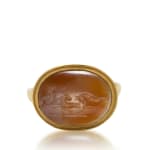Roman
A large Roman banded agate astrological intaglio set in a modern gold ring, circa 1st century AD
Agate; gold
Ring size: L; width of intaglio: 17mm
The substantial oval cabochon intaglio is engraved with an astrological scene of a charging bull, attacking a rearing lion, with a Capricorn between. The scene is believed to represent the...
The substantial oval cabochon intaglio is engraved with an astrological scene of a charging bull, attacking a rearing lion, with a Capricorn between. The scene is believed to represent the deified Julius Caesar (symbolised by the Taurus bull) and Octavian-Augustus (whose symbol was the Capricorn) as Caesar’s successor and avenger, through his triumph over Mark Antony (the Leo lion) at Actium.
Provenance
Tasmanian private collection of a lady, acquired in London in 2011Literature
This gem may be interpreted as a fascinating astrological and symbolic representation of the period after the assassination of Julius Caesar in 44 BC and the ensuing civil war which ended with the defeat of Mark Antony and Cleopatra at Actium.In the years after the assassination of Caesar, Octavian began to use iconographic images of a cosmic kind to proclaim Julius' godhead and promote his connection to his deified great-uncle and adoptive father. This can be seen in the material culture such as Augustus's coins where the Taurus bull and the Capricorn both feature on the reverse. In the years up until the Battle of Actium, Octavian was locked into a fierce struggle with Mark Antony and this gem may be seen to characterise this period of rivalry and eventual victory for Octavian.
Julius Caesar used the imagery of a bull on his coins and the emblem was adopted on the legionary standards of each legion formed under Julius Caesar. The significance of the Capricorn to Octavian-Augustus is clear though the use of the astrological motif in a variety of public art, including on coins and also on Augustan legionary standards. Augustus is depicted on the Gemma Augustea with the Capricorn emblazoned in front of his head.
The lion was a recurrent iconographic emblem on Mark Antony’s coinage, and is thought to represent the claim that the Antonii were descendants of Hercules (see Plutarch, Life of Antony, 4.1). Plutarch states that Antony believed his physical attributes confirmed this heroic descent, choosing also to attire himself in a manner suggestive of Hercules.
For further discussion of the political use of glyptics in late Republican and early Imperial Rome, see P. Gołyźniak, Engraved Gems and Propaganda in the Roman Republic and under Augustus, Oxford, 2020. For further discussion by David Wray on Augustus’s use of astrological motifs: http://fathom.lib.uchicago.edu/1/777777122543/ and on the horoscope of Augustus, see A.-M. Lewis, 'Augustus and his Horoscope Reconsidered', Phoenix, vol. 62, no. 3/4, 2008, pp. 308–337; T. Barton, 'Augustus and Capricorn: Astrological polyvalency and imperial rhetoric' The Journal of Roman Studies, 1995, 85, 33-51.



